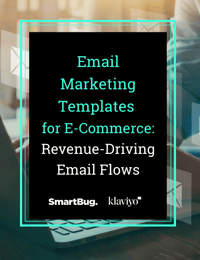
The Ultimate Email Marketing Glossary for 2022
June 2, 2022
When you’re a freshman marketer first getting started with email marketing, especially when you’re promoting an e-commerce website through Klaviyo, you’ll notice that there are a lot of important terms and acronyms that you’ll want to learn. Whether you’re brand new to the vast world of email marketing or you simply want a refresher, this article includes a glossary of the top 35 email marketing terms you need to know!
A/B Testing
Do you love science experiments? Think Weird Science mixed with Mad Men! If you’ve got a marketing hypothesis to test, A/B testing allows you to test the performance of two different versions of the same email. Not sure what type of subject line will get the best open rates? A/B test it!
Autoresponder
This is an automatic reply sent to anyone who sends email to a specific address. Going on vacation? Make sure to set an “Out of Office” autoresponder.
Bounce Rate
When sending to a specific email list, your bounce rate shows what percentage of your contacts are not accepted by your recipients’ email servers. There are two types of bounces: soft bounces and hard bounces, which we will discuss later on in this email marketing glossary. A high bounce rate can hurt the overall send health of your IP address. An acceptable bounce rate is typically below 5 percent.
Call to Action (CTA)
A call to action (CTA) is a suggestion (or an order, if you’re feeling bossy) of the next action recipients should take after reading your email. Perhaps you want to encourage them to download an e-book or purchase an item that is on sale. Use a call to action!
CAN-SPAM
Short for “Controlling the Assault of Non-Solicited Pornography And Marketing,” the CAN-SPAM Act was passed in 2003 and provides FTC oversight over marketing emails in the United States. Under the CAN-SPAM Act, emails must have a visible way to unsubscribe, among other provisions.
Click-Through Rate (CTR)
The CTR is calculated as the number of recipients who click through on a link within your email divided by the number of those who opened your email. This metric can determine whether or not users are interacting with your email content.
Here are 9 ways in which you can increase your email click-through rate.
Content Marketing
Ever hear the commonly used phrase “content is king”? Content marketing is a commonly used inbound marketing tactic that provides useful content to progress a contact through the buyer’s journey. For instance, if you’re trying to sell a specific product, a blog post about the product’s use cases may be a useful piece of content for potential buyers.
Conversion Rate
This metric determines what percentage of your email list completes a specific call to action. Is the purpose of your email to promote the sale of a specific product? Your conversion rate will be calculated by the number of contacts who purchased your product divided by the number of emails delivered.
Find out our top CRO best practices and quick wins.
DKIM
Let’s get technical for a moment. DKIM or DomainKeys Identified Mail is an email authentication technique that confirms that an email is sent by the owner of the sender domain. It’s a best practice to set this up in your email marketing platform prior to sending out any marketing emails. This will ensure emails reach their destination.
Double Opt-In
This is the practice of requiring a two-step process when a user subscribes to receive emails from you. The initial request is typically followed up by an email with a specific opt-in link. This ensures that subscribers truly want to receive emails from your brand.
Drip Campaign
Also known as an email sequence, a drip campaign is a series of emails that are sent to a prospect over a certain period of time. Drip campaigns are typically used in conjunction with a marketing automation platform.
Email Campaign
An email campaign is an email or series of emails designed to accomplish a specific marketing goal. Are you looking to drive sales for a specific product? Build out a campaign around it!
Here's how you can build an email campaign in Klaviyo.
Email Client
An email client is an application that allows you to send and receive emails from your desktop or mobile device. Commonly used email clients are Apple Mail or Microsoft Outlook.
Email List
An email list is a group of contacts within your customer relationship management (CRM) platform to which you plan to send an email campaign. Email lists can be compiled manually or through list filters.
GDPR
Does your company do business in Europe? This is an acronym you will want to learn! The General Data Protection Regulation (GDPR) went into effect in 2018 and provides strict requirements for data privacy and security in the EU. Make sure you’re GDPR compliant before sending out any campaigns to European countries.
Hard Bounce
A hard bounce is when an email cannot be delivered for a permanent reason such as an invalid email address or a blocked sender domain.
HTML Email
Do you like your messages to look prettier than the typical plain-text email? Look no further than HTML (short for hypertext markup language) to help you get creative with the design of your emails.
IP Warmup
This process involves sending to a recipient at a gradually increasing volume to build up your IP’s send reputation. This will ensure more emails will make it through the dreaded spam filter!
Lead Nurturing
Creating a lead nurture strategy involves warming up leads by sending them useful, relevant content across several different touchpoints. This is typically done through a drip campaign or email sequence workflow that encourages leads to take a specific action.
List Hygiene
A clean database helps to keep your bounce rates low. Regularly maintaining your email lists by verifying and cleaning them is a best practice when managing a CRM.
List Segmentation
Segmenting your list involves grouping contacts by specific criteria such as industry, department or customer lifecycle stage. Sending to smaller sub-sections of your email database allows you to deliver more targeted messages which leads to higher open rates.
Newsletter
A newsletter is an email sent at a regular cadence to a list of users who have opted in to receive news or updates. These can be a great way to regularly communicate with your customers.
Open Rate
This is the percentage of people who have opened your email. This is a commonly used metric for tracking email campaign performance.
Here are 9 ways in which you can increase your email open rate.
Opt-In and Opt-Out
Many brands give the option to subscribe to receive news and updates. This is what is referred to as an “opt-in.” The antithesis of this is when someone unsubscribes to your content, also known as an “opt-out.”
Personalization
Many email platforms allow the use of personalization fields that enable you to dynamically insert a contact’s personal information into an email. One of the most common examples of this is a greeting using a contact’s first name (e.g., “Hello, [First Name]”).
Plain-Text Email
This is an email that does not use HTML. Because email clients can sometimes render HTML emails differently, it’s a best practice to always give the option for recipients to view emails in HTML or plain text.
Privacy Policy
A privacy policy clearly states a company’s policy on collecting information from website visitors and what a company does and does not do with this data.
Check out Apple 2022 mail privacy updates and how they can affect email open rates.
Rendering
Rendering refers to how an email will look in a recipient’s inbox after their email client interprets the HTML code. Email clients can sometimes render emails differently which is why a thorough QA process is important when building custom emails.
Rental List
Also known as an acquisition list, this is the practice of purchasing lists of contacts who have opted in to receive information about certain topics and is typically segmented by demographic information. This is not a recommended marketing practice.
Sender Score
This scores the overall sending reputation of your IP address on a scale from 1-100. The higher your score, the more likely your emails are to be delivered to their recipients. Keeping up with regular list hygiene can help increase your sender score.
Soft Bounce
Unlike a hard bounce, a soft bounce is when an email is accepted by the server but is undeliverable due to temporary issues. This will typically happen due to a full inbox, an unavailable server, or a large email file size.
Spam or Unsolicited Commercial Email (UCE)
This is essentially the digital version of that junk mail that clutters up all of our mailboxes! These are unsolicited emails sent to contacts who have not opted in to receive messages from you. Sending spam can hurt the sender score of your IP address.
Spam Trap
Typically, when an email is sent to an email address that is no longer valid, the server will return a hard bounce notification. When traffic continues to send emails to this invalid email address, it can sometimes be turned into a spam trap. This is when the server accepts the email on behalf of the recipient and marks your email as spam. This is why it’s important to keep up with regular list hygiene.
Unsubscribe Rate (List Churn)
This is the percentage of email recipients who opt out of your list after an email send. It’s best to keep this metric as low as possible.
Whitelist
Even when a contact opts in to receive emails from you, there are several cases when they can mistakenly get caught by their spam filter. A whitelist is a list of sender email addresses that are marked as genuine (not spam). The more contacts who whitelist you, the higher your sender score will be.
Want to Go Beyond the Email Marketing Glossary and into Implementation?
Email marketing can be an incredibly powerful tool in your marketing toolkit and has use cases across almost every industry. Whether your company is just getting started with email marketing or needs help with high-level strategy, as elite partners with HubSpot and Klaviyo, SmartBug Media® is here to help! Contact us today to set up a consultation.

About the author
Shawn McFadden Born in a Cleveland Suburb, Shawn was destined to be a marketer ever since pitching his father on a Sony Playstation (True Story)! After spending 6+ years wearing lots of hats at a small agency, he came to SmartBug to show that there were brains under those hats. Formerly a multi-talented Marketing Strategist that was rockin' it for clients across a variety of industries and business types. Read more articles by Shawn McFadden.









